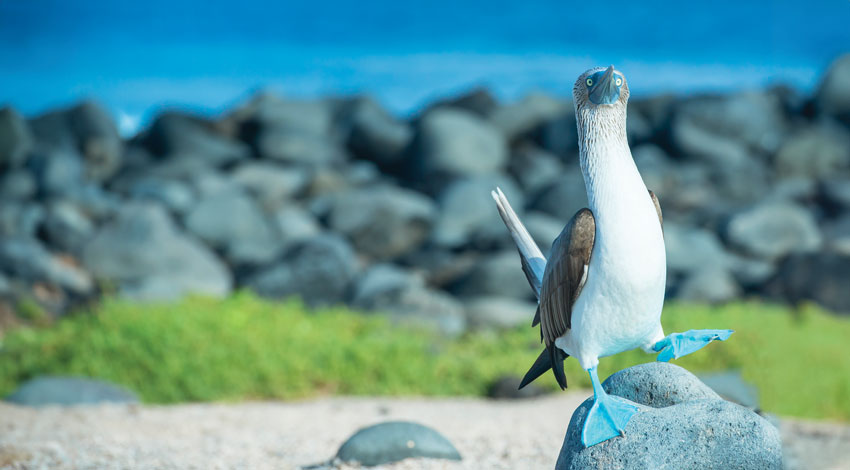Where the Wild Things Are: Discover 6 Destinations for Wildlife Study
If you are an animal lover planning your learning adventures for this year and beyond, we shine a light on a few species and their habitats that will pique your interest. From South Africa to the Sea of Cortez, a wild and woolly world is ready for you to explore. Here, we have handpicked six wildlife-rich destinations for you to discover.

1. Africa - African Savanna Elephant
Did you know there are two species of elephants in Africa? African Savanna Elephants – the larger species – roam the sprawling plains of sub-Saharan Africa, while smaller, African Forest Elephants inhabit the forests of West and Central Africa. The African Savanna Elephant is the largest living terrestrial animal on Earth, with males reaching 10 feet tall and weighing 13,000 pounds. These iconic herbivores live close to 70 years and spend their days foraging for grass, leaves, bark, fruit and foliage. Sadly, this endangered species has a declining population and faces the threat of illegal poaching.
If you would like to experience the beauty of an African Savanna Elephant with your own eyes, consider a safari with your family in South Africa, Botswana and Zambia. Explore the heart of Zimbabwe, Namibia and Botswana by land, riverboat and mokoro – a traditional canoe – on this Road Scholar learning adventure.

2. Costa Rica - Great Green Macaw
The Great Green Macaw, also known as Buffon’s or Great Military Macaw, is just one of more than 900 species of birds found in Costa Rica. Second in size to the Hyacinth Macaw, this large, highly social bird forages and roosts in groups as large as 50 individuals. Brilliant lime green feathers and a distinctive red forehead make identifying these birds easy. They dine on seeds, fruits, nuts and flowers and are particularly fond of the Almendro (mountain almond) Tree which provides both food and nesting for them.
If you love birds and wild things, you will not want to miss this chance to explore Costa Rica’s colorful world of wildlife with your family.

3. Chincoteague, Virginia – Chincoteague Pony
The magical island of Chincoteague has fascinated children and horse-lovers for generations. Its most famous resident, Misty, the wild Chincoteague Pony, is the main character in “Misty of Chincoteague” by Marguerite Henry. Today, two herds of wild horses live on Assateague Island, with a fence separating them at the Maryland-Virginia border. The National Park Service manages the Maryland herd, while the Chincoteague Volunteer Fire Company owns the Virginia herd. A colorful sight, the ponies have pinto or solid coats of bay, chestnut, black or palomino.
Visit restricted areas of the wildlife refuge on the island and immerse yourself in one of the longest undeveloped shorelines on the Atlantic coast on this one-of-a-kind learning adventure with Road Scholar.

4. Galapagos Islands – Blue-footed Booby
The Galapagos Islands are renowned for their abundant and biodiverse range of animal and plant species. One familiar resident, the Blue-footed Booby, is a marine bird that is easily recognizable because of its brightly colored Tiffany blue feet. These pescatarians fly far out to sea searching for anchovies, sardines, mackerel and flying fish. In addition, you’ll see penguins, giant tortoises, sea lions, marine iguanas and many species of birds in this naturalist’s dream destination.

5. Baja Peninsula, Mexico – Gray Whale
Nestled between the Mexican mainland and Baja California, the Sea of Cortez is home to an extraordinary array of marine life. Calm waters hug coastlines of sand, making the Sea of Cortez a safe harbor for migrating and spawning Gray Whales. Since the harvesting of Gray Whales was banned in 1946, populations of this species have rebounded. You will surely have a whale of time in Mexico’s Baja Peninsula.

6. Cape May, New Jersey – Peregrine Falcon
Peregrine means wander, and boy does this raptor like to travel. The Peregrine Falcon has one of the longest migrations of any North American bird. It has been tracked traveling more than 15,000 miles in a year between its winter home in South America and summer nesting sites as far north as the Arctic tundra. This long-distance traveler uses the Atlantic Flyway — a major north-south route for migratory birds. The busiest super highway in the sky, this flyway is the choice of more than 500 species of birds and traverses Cape May, New Jersey. Here, the Peregrine Falcon’s migration peaks in early October. You’ll also see millions of other birds as they follow the North American coastline. And, whenever you visit, the year-round Bald Eagle is easily visible in its nest high above the water. Whether you visit in the spring or fall, Cape May is a mecca for birds and birders alike.
Ready to learn more about wildlife around the world? Check out all of our favorite nature and animal adventures!
